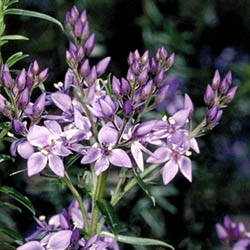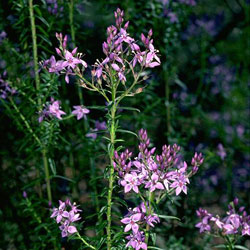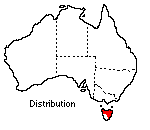Veronica formosa
 |
 |
Speedwell Bush
Veronica formosa, a member of the Plantaginaceae family, is endemic to Tasmania and grows on rocky hillsides from sea-level to altitudes of about 1200 m. It has been sighted at Port Dalrymple on the north-east coast and on Mt Wellington. The species was previously known as Hebe formosa.
 The
plant is a perennial shrub ranging in height from 0.5 to 2 m depending on its
growing conditions. The glabrous, dark-green leaves distinguish this species
when it is not in flower. They are thickish and small, 7-15 mm long, elliptical to lanceolate and are arranged in close-set, opposite pairs with the bases of each pair fused
across the stem. In late spring and early summer it blooms profusely and is
covered with many small flowers varying in colour from pale lilac to violet
blue. These typical Veronica f lowers have an unequal four-lobed corolla
with two exserted stamens and are carried in racemes which are numerous in the axils of the upper leaves, forming a leafy branched
inflorescence.
The
plant is a perennial shrub ranging in height from 0.5 to 2 m depending on its
growing conditions. The glabrous, dark-green leaves distinguish this species
when it is not in flower. They are thickish and small, 7-15 mm long, elliptical to lanceolate and are arranged in close-set, opposite pairs with the bases of each pair fused
across the stem. In late spring and early summer it blooms profusely and is
covered with many small flowers varying in colour from pale lilac to violet
blue. These typical Veronica f lowers have an unequal four-lobed corolla
with two exserted stamens and are carried in racemes which are numerous in the axils of the upper leaves, forming a leafy branched
inflorescence.
Veronica formosa will grow in most soils. Although it flowers better in the sun, it will tolerate shade. In its natural environment it is regarded as being frost-hardy and can withstand frosts up to -7ºC. The species is ideal as a rockery plant as it will spread over rocks and reaches a height of 60 to 70 cm. V. formosa responds well to pruning as it tends to become lanky. In winter the old stems should be cut back to make the plant more compact. V. formosa is best propagated by cuttings taken in late January and these take about six weeks to strike. There are many specimens of this attractive species growing in various locations in the Australian National Botanic Gardens.
Text by Tim Mulcahy, ANBG (1986)
Look here for a glossary of botanical terms.
Name meaning: Veronica formosaVeronica - from mediaeval Latin, supposedly a corruption of the Latin, vera icon, true image, referring to the image of Christ imprinted on the cloth with which St Veronica wiped his face - the name subsequently assumed to be in honour of the saint herself; formosa - from Latin, beautiful or handsome. |
![An Australian Government Initiative [logo]](/images/austgovt_brown_90px.gif)

